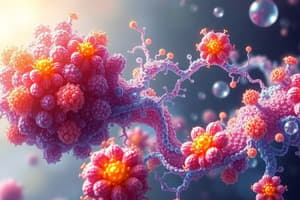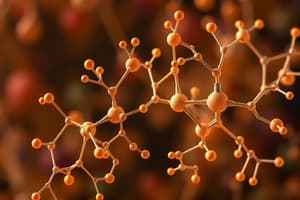Podcast
Questions and Answers
Which of the following characteristics distinguishes secondary metabolites from primary metabolites?
Which of the following characteristics distinguishes secondary metabolites from primary metabolites?
- Their restricted distribution among organisms. (correct)
- Their universal presence in all living organisms.
- Their direct involvement in synthesizing proteins and fats.
- Their role in essential life processes.
A plant produces a chemical that inhibits the growth of nearby tomato plants. This is an example of which type of secondary metabolite function?
A plant produces a chemical that inhibits the growth of nearby tomato plants. This is an example of which type of secondary metabolite function?
- Defense against predators
- Protection from cosmic rays
- Attraction of pollinators
- Allelopathic agent (correct)
Why are carbohydrates considered primary metabolites?
Why are carbohydrates considered primary metabolites?
- They are only produced during photosynthesis.
- They are only found in plants.
- They are not essential for energy storage.
- They are the most abundant constituents of plants, animals, and microorganisms. (correct)
During photosynthesis, light energy is used to produce which of the following?
During photosynthesis, light energy is used to produce which of the following?
What structural characteristic is used to designate sugars as D or L isomers?
What structural characteristic is used to designate sugars as D or L isomers?
Glycerol has what properties at room temperature?
Glycerol has what properties at room temperature?
Which of the following is a use for the calcium salt of gluconic acid?
Which of the following is a use for the calcium salt of gluconic acid?
High fructose corn syrup is created through which process?
High fructose corn syrup is created through which process?
What condition is glucosamine commonly used to treat?
What condition is glucosamine commonly used to treat?
Invert sugar is produced from sucrose through which process?
Invert sugar is produced from sucrose through which process?
Flashcards
Primary Metabolism
Primary Metabolism
Complex network of biochemical reactions synthesizing, degrading, and interconverting compounds in organisms.
Secondary Metabolism
Secondary Metabolism
Compounds with restricted distribution, formed from primary metabolites, and non-essential for life but important to the organism.
Allelopathic agents
Allelopathic agents
Biochemicals released influencing germination, growth and reproduction of surrounding organisms.
Carbohydrates
Carbohydrates
Signup and view all the flashcards
Monosaccharides
Monosaccharides
Signup and view all the flashcards
Glycerol (Glycerin)
Glycerol (Glycerin)
Signup and view all the flashcards
D-Glucose
D-Glucose
Signup and view all the flashcards
D-Fructose
D-Fructose
Signup and view all the flashcards
Vitamin C
Vitamin C
Signup and view all the flashcards
Glucosamine
Glucosamine
Signup and view all the flashcards
Study Notes
Primary and Secondary Metabolism
- Primary metabolism involves intricate biochemical reactions for synthesizing, degrading, and interconverting compounds in all organisms.
- Primary metabolites are characterized by broad distribution in all living things and are essential for life processes.
- Examples of primary metabolites include carbohydrates, proteins, fats, and nucleic acids.
- Secondary metabolites are distinguished from primary metabolites through restricted distribution, individuality, origin from primary metabolites, non-essentiality to life, production conditions, biogenesis, and unknown functions.
- Reasons for secondary metabolite production include defense against predators, attraction, cosmic ray protection, and allelopathic effects.
- Secondary metabolites are harvested by humans for use as medicines, nutritional supplements, and agrochemicals.
- Examples of medicines derived from secondary metabolites include antibiotics like penicillin, enzyme inhibitors, immunomodulators, and antitumor agents like Taxol.
Primary Metabolism: Photosynthesis
- Photosynthesis is the process by which autotrophic organisms use light energy to convert carbon dioxide and water into sugar and oxygen.
- The light reactions of photosynthesis use solar energy to produce ATP and NADPH, providing chemical energy and reducing power for the Calvin cycle.
- The Calvin cycle incorporates CO2 into organic molecules, which are then converted to sugar.
- Most simple sugars have formulas that are some multiple of CH2O.
Primary Metabolites: Carbohydrates
- Carbohydrates are the most abundant constituents of plants, animals, and microorganisms.
- Carbohydrates function as important food reserves and structural components in cell walls.
- Animals and microorganisms depend on carbohydrates produced by plants, and the name means "carbon hydrate", consisting of Carbons + H2O
- Sugars or saccharides are terms used to cover carbohydrate materials.
Monosaccharides
- Monosaccharides are simple sugars, aldehyde or ketone derivatives of straight-chain polyhydroxy alcohols containing at least three carbon atoms.
- Stereochemical designations of D and L sugars are based on the hydroxyl position on the chiral carbon farthest from the carbonyl group in the Fischer projection.
- All D-sugars have the -OH on the right side, while L-sugars have the -OH on the left side.
Examples of Monosaccharides
- Glycerol (Glycerin) is a polyhydroxy alcohol that is colorless, odorless, sweet, and viscous at room temperature.
- Uses of Glycerol: FDA approved treatment for wounds, pharmaceutical industry, Solvent, Humectant, Moisturizer, Laxative, Electronic cigarette liquid, Antifreeze, Bubble mixture and production of dynamite.
- D-Glucose, Dextrose (Grape Sugar) is found naturally in grapes and other fruits and obtained by enzymatic hydrolysis of starch.
- Uses of Glucose: Nutrient intravenously (IV).
- Chemical oxidation converts the aldehyde function to a carboxylic acid and produces gluconic acid.
- Calcium salt of gluconic acid is used as an intravenous calcium supplement.
- Sodium salt of gluconic acid is used as a detergent in bottle washing and as an additive in cement and in paper industry.
- D-Fructose (Fruit Sugar) is a simple monosaccharide sugar found in fruits and obtained from invert sugar separating it from glucose.
- Uses of Fructose: As food and sweetener for patients who cannot tolerate glucose-e.g., diabetics.
- Properties: The sweetness of sucrose is about twice that of glucose.
- High Fructose Corn Syrup: Used as a food sweetener and in many types of medicines, is a mixture of fructose (90%) and glucose, and is produced by enzymatic hydrolysis/isomerization of starch
- Vitamin C (Ascorbic Acid): A y-lactone synthesized by plants and almost all animals except primates and guinea pigs.
- Properties: It is rapidly degraded during cooking in the presence of air, in animals. synthesized in the liver from glucose and in plants: synthesized from L-galactose.
- Rich Sources: Citrus fruits, Peppers, Guavas, rose hips and blackcurrants
- Benefits: the formation of collagen, promotes healing by increasing collagen synthesis and alleviation of common cold other viral infection.
- Clinical Syndrome: A deficiency of vitamin C is Scurvy.
- Glucosamine: An amino monosaccharide synthesized from fructose 6-phosphate and glutamine.
- Uses: A biochemical precursor of all nitrogen-containing sugars, it is the building blocks of cartilage and as supplements are made from animal sources such as crab, lobster, or shrimp shells.
Oligosaccharides
-
Sucrose is the most abundant disaccharide, found in the plant kingdom, and familiar as common table sugar.
-
Sucrose is a sweetening agent for foods, syrups, and drug preparations.
-
Obtained from: Sugar cane (Graminae/Poaceae), Sugar beet (Chenopodiaceae), and Sugar maple (Aceraceae).
-
Invert Sugar is an equimolar mixture of glucose and fructose obtained from sucrose by hydrolysis with acid or the enzyme invertase.
-
Sucrose is dextrorotatory, while invert sugar is levorotatory.
-
Invert Sugar: Less calorific food sweetener than sucrose and is found in honey.
-
The Invertase enzyme, found in the saliva of the bee, converts sucrose to fructose and glucose and it is a blend of sugars.
-
Sucralose is a semi-synthetic derivative of sucrose produced by selective chlorination and is 600 times sweeter than sucrose, It did not break down in the body by the enzyme sucrase and is used as a sweetening agent
-
Lactulose is a semi-synthetic disaccharide prepared from lactose and composed of galactose, linked to fructose, it is not absorbed, helps retain fluid in the bowel by osmosis, and functions as a laxative.
Studying That Suits You
Use AI to generate personalized quizzes and flashcards to suit your learning preferences.




